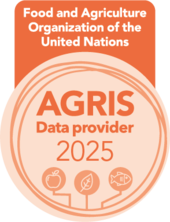Native edible mushroom "Qipatari" (Basidiomycota): Strain production, mycelial growth on lignocellulosic substrates, fruiting body production, and nutritional content
DOI:
https://doi.org/10.57188/manglar.2025.015Keywords:
nutraceutical, native fungus, Pampa River, Apurimac, mesoandean forestAbstract
Native edible mushrooms represent a potential source of food and bioactive compounds with nutraceutical applications. In this study, the cultivation and nutritional value of the native mushroom "Qipatari," collected in the town of Rio Blanco (Los Chankas District), Apurimac, Peru, were evaluated. The objectives were to obtain the mushroom strain, perform its cultivation, and determine the nutritional content of wild and cultivated carpophores. Preliminary molecular analysis of the fungus showed similarities of 88.30% – 89.97% with Lentinus levis and 88.49% with Pleurotus cytidiosus var. formosensis. Fruiting was optimal in a substrate composed of 80% wheat stover and 20% alder sawdust. Eight essential amino acids were identified, most notably alanine (268.1 mg/100 g) and lysine (123.0 mg/100 g), in addition to fatty acids such as linoleic acid (3.288 mg/100 g) and free sugars such as fructose and glucose. Wild and cultivated carpophores had higher ash, fiber, and calcium contents than commercial mushrooms Lentinula edodes and P. ostreatus, while protein content was similar. The reported edibility of “Qipatari”, its cultivation, and nutritional content are new contributions to science, providing a basis for its commercial production and conservation.
Downloads
References
Aguilar-Pumahuillca, F., Huamán-Huamán, H., & Holgado-Rojas, M. (2019). Caracterización de Pleurotus sp. aislado de la Comunidad Nativa de Korimani, Centro Poblado de Kiteni-Echarate, La Convención, Cusco, Perú. Ecología Aplicada, 18(1), 45-50. https://doi.org/10.21704/rea.v18i1.1305
Ahmed, R., Niloy, M. A. H. M., Islam, M. S., Reza, M. S., Yesmin, S., Rasul, S. B., & Khandakar, J. (2024). Optimizing tea waste as a sustainable substrate for oyster mushroom (Pleurotus ostreatus) cultivation: A comprehensive study on biological efficiency and nutritional aspect. Frontiers in Sustainable Food Systems, 7. https://doi.org/10.3389/fsufs.2023.1308053
Albertó, E. (2017). Naturally occurring strains of edible mushrooms: A source to improve the mushroom industry. En C. Z. Diego & A. Pardo-Giménez (Eds.), Edible and medicinal mushrooms (cap. 19). https://doi.org/10.1002/9781119149446.ch19
Albertó, E. (2008). Cultivo intensivo de los hongos comestibles: Cómo cultivar champiñones, gírgolas, shiitake y otras especies (1ª ed.). Editorial Hemisferio Sur.
Alim, Y., Sidhoum, W., & Dib, S. (2023). First record of the edible mushroom Lepista sordida in Western Algerian Forest: Nutritional value and physicochemical parameters of mycelial culture. Journal of Fungi, 9(8), 858. https://doi.org/10.3390/jof9080858
Arana-Gabriel, Y., Burrola-Aguilar, C., Alcalá-Adán, A., Zepeda, C., & Estrada-Zúñiga, M. (2020). Mycelial growth of the edible wild mushrooms Floccularia luteovirens in different culture mediums and pH. AgroProductividad, 13, 33-38. https://doi.org/10.32854/agrop.v13i10.1745
Ayimbila, F., & Keawsompong, S. (2023). Nutritional quality and biological application of mushroom protein as a novel protein alternative. Current Nutrition Reports, 12(4), 281-298. https://doi.org/10.1007/s13668-023-00468-x
Cano, A., & Romero, L. (2016). Valor económico, nutricional y medicinal de hongos comestibles silvestres. Revista Chilena de Nutrición, 43(1), 75-80.
Chang, S. T., & Miles, P. G. (2004). Mushrooms: Cultivation, nutritional value, medicinal effect, and environmental impact. CRC Press.
Chang, S. T., & Miles, P. G. (1989). Edible mushrooms and their cultivation. CRC Press.
Chimey, C., & Holgado, M. E. (2010). Los hongos comestibles silvestres y cultivados en Perú. En D. Martínez-Carrera, N. Curvetto, M. Sobal, P. Morales, & V. M. Mora (Eds.), Hacia un desarrollo sostenible del sistema de producción-consumo de los hongos comestibles y medicinales en Latinoamérica: Avances y perspectivas en el siglo XXI (pp. 381-395). Red Latinoamericana de Hongos Comestibles y Medicinales-COLPOS-UNS-CONACYT-AMC-UAEM-UPAEP-MINAP.
Curvetto, N., Figlas, D., & Delmastro, S. (2002). Sunflower seed hulls as substrate for the cultivation of shiitake mushrooms. HortTechnology, 12(4), 652-655. https://doi.org/10.21273/HORTTECH.12.4.652
Dávila-Arenas, C., Sulca-Quispe, L., & Pavlich-Herrera, M. (2018). Estudio Etnomicológico de la micobiota comestible en dos Comunidades Nativas de la Cuenca Alto Madre de Dios, Reserva Biósfera Del Manu. Sagasteguiana, 1(1), 121-130.
Delgado, N., Miranda, V., Barros, J., Isla, M., & Fracchia, S. (2024). Exploring local lignocellulosic substrates for the production of edible mushrooms in Northwestern Argentina. Lilloa, 61(2), 317-339. https://doi.org/10.30550/j.lil/1973
De Jesús-Rivera, L., Álvarez-Sánchez, M. E., Ramírez-Pérez, F., & Maldonado-Torres, R. (2022). Prickly pear glochids for commercial production of oyster mushroom. Revista Mexicana de Ciencias Agrícolas, 13(8), 1445–1454. https://doi.org/10.29312/remexca.v13i8.3351
Fernández, F. (2005). Manual práctico de producción comercial de champiñón. Guadalajara, Jalisco, México.
Fu, Y. P., Dai, Y. T., Chethana, K. W. T., Li, Z. H., Sun, L., Li, C. T., Yu, H. L., Yang, R. H., Tan, Q., Bao, D. P., Deng, Y. J., Wang, S. X., Wang, Y. F., Tian, F. H., Qi, L. L., Shu, L. L., Jia, P. S., Chen, L. C., Chen, M. Y., Hu, Q. X., Tan, H., Song, T. T., Zhang, Z. W., Bonito, G., Zervakis, G. I., Xiao, S. J., Hyde, K. D., Li, Y., & Yuan, X. H. (2022). Large-scale genome investigations reveal insights into domestication of cultivated mushrooms. Mycosphere, 13(2), 86–133. https://doi.org/10.5943/mycosphere/si/1f/4
Gaitán-Hernández, R., Salmones, D., Pérez, R., & Mata, G. (2006). Manual práctico del cultivo de setas: Aislamiento, siembra y producción. Xalapa: Instituto de Ecología.
García, M. (2007). Cultivo de setas y trufas. Mundi-Prensa Libros.
Holgado, M. E., Aranzabal, R., Lazarte, R., Quispe, A., Pérez, K. A., Aguilar, F. B., & Aguilar, F. (2019). Cultivo de Pleurotus spp. y Lentinula edodes bajo condiciones artesanales en comunidades campesinas de la Región Cusco. Revista de Ecología Aplicada, 18(2). https://doi.org/10.21704/rea.v18i2.1331
Jaramillo, S., & Albertó, E. (2019). Incremento de la productividad de Pleurotus ostreatus mediante el uso de inóculo como suplemento. Scientia Fungorum, 49, e1243. https://doi.org/10.33885/sf.2019.49.1243
Jasinska, A. (2023). Sustainability of mushroom cultivation systems. Horticulturae, 9(11), 1191. https://doi.org/10.3390/horticulturae9111191
Kalac, P. (2013). A review of chemical composition and nutritional value of wild-growing and cultivated mushrooms. Journal of the Science of Food and Agriculture, 93, 209-218. https://doi.org/10.1002/jsfa.5960
Kumar, P., Eid, E. M., Al-Huqail, A. A., Širić, I., Adelodun, B., Abou Fayssal, S., Valadez-Blanco, R., Goala, M., Ajibade, F. O., Choi, K. S., & Kumar, V. (2022). Kinetic studies on delignification and heavy metals uptake by shiitake (Lentinula edodes) mushroom cultivated on agro-industrial wastes. Horticulturae, 8(4), 316. https://doi.org/10.3390/horticulturae8040316
Kumawat, A., Wasnikar, A. R., Kumawat, H., Kumawat, G., Kumawat, K. C., & Rani, K. (2024). Insight into the effect of crop straw on production of oyster mushroom (Pleurotus ostreatus). Biological Forum – An International Journal, 16(7), 300-303.
Kumla, J., Suwannarach, N., Sujarit, K., Penkhrue, W., Kakumyan, P., Jatuwong, K., Vadthanarat, S., & Lumyong, S. (2020). Cultivation of mushrooms and their lignocellulolytic enzyme production through the utilization of agro-industrial waste. Molecules, 25, 2811. https://doi.org/10.3390/molecules25122811
Lallawmsanga, A., & Carrasco, B. (2022). Diversity of the fungi kingdom: Molecular tools to distinguish mushrooms considered safe and unsafe for human health. En D. Stojković & L. Barros (Eds.), Edible fungi: Chemical composition, nutrition, and health effects (Chapter 1, pp. 1-22). Food Chemistry, Function and Analysis (Vol. 36). The Royal Society of Chemistry.
López, A. (2007). Manual de producción de micelio de hongos comestibles. Instituto de Genética Forestal-Universidad de Veracruz, México.
Mata, G., & Guzmán, G. (1993). Cultivation of Lentinus boryanus in wood shavings in Mexico. Cryptogamic Botany, 4, 47–49.
Muswati, C., Simango, K., Tapfumaneyi, L., Mutetwa, M., & Ngezimana, W. (2021). The effects of different substrate combinations on growth and yield of oyster mushroom (Pleurotus ostreatus). International Journal of Agronomy, 2021, Art. 9962285. https://doi.org/10.1155/2021/9962285
Mushworld. (2005). Handbook of cultivators - Shiitake. Seúl, Corea del Sur: Editorial Haeng-oon.
Naim, L., Alsanad, M., El Sebaaly, Z., Shaban, N., Abou Fayssal, S., & Sassine, Y. (2020). Variation of Pleurotus ostreatus (Jacq. ex Fr.) P. Kumm. (1871) performance subjected to different doses and timings of nano-urea. Saudi Journal of Biological Sciences, 27, 2794–2801. https://doi.org/10.1016/j.sjbs.2020.03.019
Omarini, A., Lechner, B. E., & Albertó, E. (2009). Polyporus tenuiculus: A new naturally occurring mushroom that can be industrially cultivated on agricultural waste. Journal of Industrial Microbiology & Biotechnology, 36, 635–642. https://doi.org/10.1007/s10295-009-0530-2
Okuda, Y. (2022). Sustainability perspectives for future continuity of mushroom production: The bright and dark sides. Frontiers in Sustainable Food Systems, 6, 1026508. https://doi.org/10.3389/fsufs.2022.1026508
Pavlich, M. R. (2001). Los hongos comestibles del Perú. Revista de Ciencias Biológicas BIOTA, 18, 3-19.
Pérez-Moreno, J., Mortimer, P. E., Xu, J., Karunarathna, S. D. O., & Li, H. (2021). Global perspectives on the ecological, cultural and socioeconomic relevance of wild edible fungi. Studies in Fungi, 6(1), 408-424. https://doi.org/10.5943/sif/6/1/31
Ramírez-Terrazo, A., Montoya, A., & Kong, A. (2021). Conocimiento micológico tradicional en dos comunidades aledañas al Parque Nacional Lagunas de Montebello, Chiapas, México. Scientia Fungorum, 51, e1321. https://doi.org/10.33885/sf.2021.51.1321
Raza, M. H., Abid, M., Faisal, M., Yan, T., Akhtar, S., & Adnan, K. M. M. (2022). Environmental and health impacts of crop residue burning: Scope of sustainable crop residue management practices. International Journal of Environmental Research and Public Health, 19(8), 4753. https://doi.org/10.3390/ijerph19084753
Roncero, I. (2015). Propiedades nutricionales y saludables de los hongos. Centro Tecnológico de Investigación del Champiñón de La Rioja (CTICH).
Rugolo, M., Mascoloti Spréa, R., Dias, M. I., Pires, T. C. S. P., Añibarro-Ortega, M., Barroetaveña, C., Caleja, C., & Barros, L. (2022). Nutritional composition and bioactive properties of wild edible mushrooms from native Nothofagus Patagonian forests. Food, 11(21), 3516. https://doi.org/10.3390/foods11213516
Salmones, D., Gaitán-Hernández, R., Pérez, R., & Guzmán, G. (1997). Studies on genus Pleurotus. VIII. Interaction between mycelial growth and yield. Revista Iberoamericana de Micología, 14, 173-176.
Sánchez, Ó. J., & Montoya, S. (2020). Assessment of polysaccharide and biomass production from three white-rot fungi by solid-state fermentation using wood and agro-industrial residues: A kinetic approach. Forests, 11(10), 1055. https://doi.org/10.3390/f11101055
Sánchez, J. E., & Royse, D. (2001). La biología y el cultivo de Pleurotus spp. El Colegio de la Frontera Sur, Carretera Panamericana y Periférico Sur s/n, Barrio de María Auxiliadora
Sande, D., Pereira de Oliveira, G., Fidelis, M. A., Martins, B. A., Lima, M. T. N. S., & Takahashi, J. A. (2019). Edible mushrooms as a ubiquitous source of essential fatty acids. Food Research International, 125, 108524. https://doi.org/10.1016/j.foodres.2019.108524
Stamets, P., & Chilton, J. (1983). The mushroom cultivator: A practical guide to growing mushrooms at home. Agarikon Press.
Teja, K. S., Suruchi, Rai, U., Kumar, M., Mohanty, O., Roy, J., & Meshram, S. (2023). Mushrooms: A potential option in the management of deficiency and diseases in humans. Journal of Pure and Applied Microbiology, 17(2), 749-760. https://doi.org/10.22207/JPAM.17.2.55
Tekeste, N., Dessie, K., Taddesse, K., & Ebrahim, A. (2020). Evaluation of different substrates for the yield and yield attributes of oyster mushroom (Pleurotus ostreatus) in the crop-livestock system of northern Ethiopia. The Open Agriculture Journal, 14(1), 30–40. https://doi.org/10.2174/1874331502014010030
Trutmann, P., Luque Luque, A., Holgado Rojas, M., Quispe Pelaez, A., Callañaupa Auccapuma, M., López Mesones, M., & Pavlich Herrera, M. (2022). The mushrooms of Andean Peru: Part 1. Order Agaricales: Families Agaricaceae to Lyophyllaceae (1st ed.). Global Mountain Action Publications, Orselina, Switzerland. ISBN-13: 979-8987167014.
Wan Mahari, W. A., Peng, W., Nam, W. L., Yang, H., Lee, X. Y., Lee, Y. K., Liew, R. K., Ma, N. L., Mohammad, A., Sonne, C., Van Le, Q., Show, P. L., Chen, W.-H., & Lam, S. S. (2020). A review on the valorization of oyster mushrooms and the waste generated in the mushroom farming industry. Journal of Hazardous Materials, 400, 123156. https://doi.org/10.1016/j.jhazma.2020.12
Yin, Y., Chen, B., Xu, S., Zuo, J., Xu, Y., Xiong, S., & Chen, F. (2025). Investigation of crop straw for edible and medicinal fungi cultivation: Assessment of lignocellulose preprocessing and spent substrate biofuel properties. Industrial Crops and Products, 223, 120004. https://doi.org/10.1016/j.indcrop.2024.120004
Zariquiey, R., & Córdova, G. (2008). Qayna, Kunan, Paqarin: Una introducción práctica al quechua chanca. Estudios Generales Letras - Pontificia Universidad Católica del Perú.
Zied, D. C., Pardo, J. E., Noble, R., & Pardo-Giménez, A. (2024). Efficiency of mushrooms for food production—Fundamental strategic decision-making. Journal of Food Composition and Analysis, 125, 105734. https://doi.org/10.1016/j.jfca.2024.105734
Downloads
Published
Issue
Section
License
Copyright (c) 2025 Karin Antonieta Pérez-Leguía, Albino Quispe-Pelaez, María Encarnación Holgado-RojasMaría Encarnación Holgado-Rojas

This work is licensed under a Creative Commons Attribution 4.0 International License.

Manglar is an open access journal distributed under the terms and conditions of Creative Commons Attribution 4.0 International license









